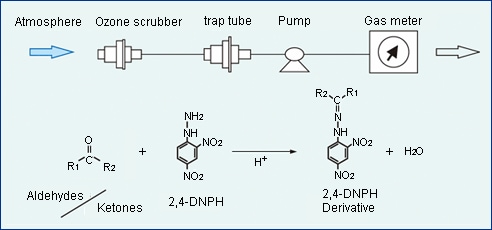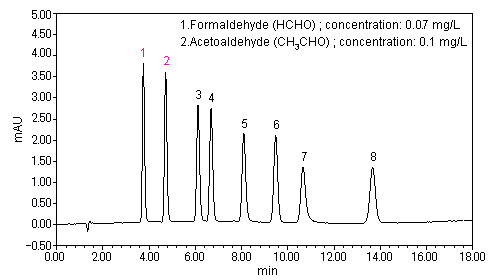Analysis of 2,4-DNPH-Derivatized Aldehydes
Sick house syndrome, a syndrome in which air polluted by chemical substances dissipated from house building materials, interiors, etc., causes human health problems, has become an issue. Accordingly, in Japan the measurement of chemical substances such as formaldehyde and volatile organic compounds (VOC) became mandatory in 2002 and 2003, as directed by the Ministry of Education, Culture, Sports, Science and Technology, the Ministry of Land, Infrastructure, Transport and Tourism, and the Ministry of Health, Labor and Welfare. In addition, starting from March 1, 2009, working environment concentration controls were established for the production and all handling work of formaldehyde.
Since aldehydes are not detected in a highly sensitive manner by UV detection methods, HPLC is utilized to measure solvent extracted samples of aldehydes from ambient air collected in trap tubes and derivatized*1 with 2,4-dinitrophenylhydrazine (DNPH).
The following describes examples of analysis of 2,4-DNPH derivatized aldehydes.
*1:
Example of 2.4-DNPH derivatization
Aldehyde is derivatized by suctioning ambient air into trap tubes filled with 2,4-DNPH- impregnated silica gel. Injection samples are prepared by eluting the -aldehyde with acetonitrile.

Analysis of 2,4-DNPH-Derivatized Aldehydes
Standard Samples
DNPH derivatized aldehydes
- Formaldehyde-DNPH
- Acetaldehyde-DNPH
- Acetone-DNPH
- Propionaldehyde-DNPH
- Crotonaldehyde-DNPH
- Isobutylaldehyde-DNPH
- Benzaldehyde-DNPH
- N-valeraldehyde-DNPH
Used after preparation with acetonitrile and dilution as required
Conditions
| Column | HITACHI LaChrom C18 (5 µm) (4.6 mmI.D. x 150 mm) |
|---|---|
| Elute | CH3CN : H2O = 60/40 (v/v) |
| Flow rate | 1.0 mL/min |
| Column Temperature | 40°C |
| Detection | DAD 360 nm |
| Injection vol. | 10 µL |
System configuration
5110 Pump
5210 AutoSampler
5310 Column Oven
5420 UV-VIS Detector
Empower2 Data Processing System
Analysis results of standard samples

NOTES:
0.07 mg/L (0.07 ppm), the concentration of formaldehyde in the sample solution, is equal to a concentration of 0.02 µg/m3 formaldehyde in ambient air eluted with acetonitrile at a constant volume (10 mL) after collection via suction with a pump at 1 L/min for 30 minutes, as shown in Figure 1. Therefore, the Chromaster is suitable for measurement of formaldehyde at concentrations of 100 µg/m3, the indoor concentration monitoring standard for formaldehyde established by Ministry of Health, Labor and Welfare, and 0.1 ppm, the control concentration established by the Occupational Health and Safety Law.
NOTE:
These data are an example of measurement; the individual values cannot be guaranteed.
The system is for research use only, and is not intended for any animal or human therapeutic or diagnostic use.
In order to read a PDF file, you need to have Adobe® Reader®
